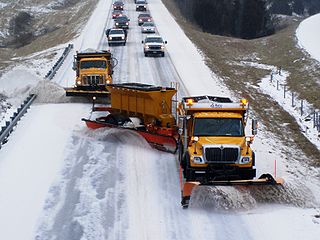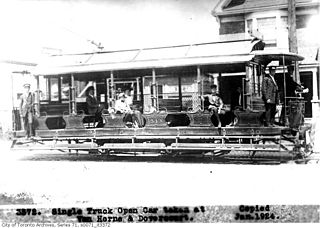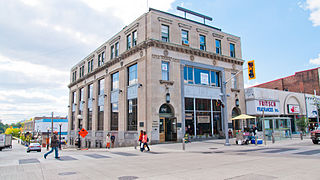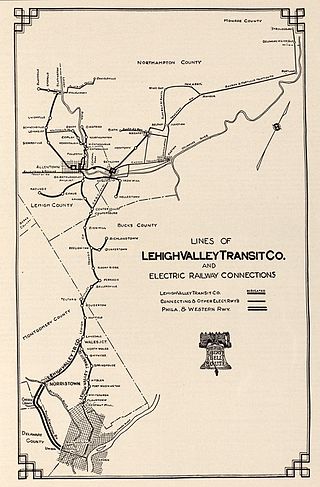
The interurban is a type of electric railway, with tram-like electric self-propelled railcars which run within and between cities or towns. The term "interurban" is usually used in North America, with other terms used outside it. They were very prevalent in many parts of the world before the Second World War and were used primarily for passenger travel between cities and their surrounding suburban and rural communities. Interurban as a term encompassed the companies, their infrastructure, their cars that ran on the rails, and their service. In the United States, the early 1900s interurban was a valuable economic institution, when most roads between towns, many town streets were unpaved, and transportation and haulage was by horse-drawn carriages and carts.

The Chicago Tunnel Company was the builder and operator of a 2 ft narrow-gauge railway freight tunnel network under downtown Chicago, Illinois. This was regulated by the Interstate Commerce Commission as an interurban even though it operated entirely under central Chicago, did not carry passengers, and was entirely underground. It inspired the construction of the London Post Office Railway.

A Birney or Birney Safety Car is a type of streetcar that was manufactured in the United States in the 1910s and 1920s. The design was small and light and was intended to be an economical means of providing frequent service at a lower infrastructure and labor cost than conventional streetcars. Production of Birney cars lasted from 1915 until 1930, and more than 6,000 of the original, single-truck version were built. Several different manufacturers built Birney cars. The design was "the first mass-produced standard streetcar " in North America.
The St. Louis Car Company was a major United States manufacturer of railroad passenger cars, streetcars, interurbans, trolleybuses and locomotives. It operated from 1887 to 1974 and was based in St. Louis, Missouri.

A snowplow is a device intended for mounting on a vehicle, used for removing snow and ice from outdoor surfaces, typically those serving transportation purposes. Although this term is often used to refer to vehicles mounting such devices, more accurately they are known as winter service vehicles, especially in areas that regularly receive large amounts of snow every year, or in specific environments such as airfields. In other cases, pickup trucks and front end loaders are outfitted with attachments to fulfill this purpose. Some regions that do not frequently see snow may use graders to remove compacted snow and ice off the streets. Snowplows can also be mounted on rail cars or locomotives to clear railway tracks.

The Toronto Railway Company (TRC) was the operator of the streetcar system in Toronto between 1891 and 1921. It electrified the horsecar system it inherited from the Toronto Street Railway, the previous operator of streetcar service in Toronto. The TRC was also a manufacturer of streetcars and rail work vehicles, a few of which were built for other streetcar and radial operators.

The J. G. Brill Company manufactured streetcars, interurban coaches, motor buses, trolleybuses and railroad cars in the United States for nearly 90 years, hence the longest-lasting trolley and interurban manufacturer. At its height, Brill was the largest manufacturer of streetcars and interurban cars in the US and produced more streetcars, interurbans and gas-electric cars than any other manufacturer, building more than 45,000 streetcars alone.

The Ottawa Car Company was a builder of streetcars for the Canadian market and was founded in Ottawa, Ontario, in 1891 as an outgrowth of the carriage building operations of William W. Wylie. Its plant was located at Kent and Slater Streets, a short distance from Parliament Hill. The company was a subsidiary of Ottawa Electric Railway, in turn controlled by Ahearn & Soper.

The Connecticut Trolley Museum, also known as the Warehouse Point Trolley Museum, is the oldest incorporated museum dedicated to electric railroading in the United States. Founded in October 1940, the museum is located in East Windsor, Connecticut and is open to the public April through December. The museum features static and moving displays, and self-guided tours of the state's trolley history.
The Texas Transportation Company was an electrified, Class III, short-line railroad in San Antonio, Texas, that operated from 1897 until 2001. It served the Pearl Brewery and several other businesses, moving carloads between those businesses and the Southern Pacific yard. Service ended on June 30, 2000, shortly before the Pabst Brewing Company closed the Pearl Brewery, in early 2001.

The Kitchener Public Utilities Commission was the municipal public utilities commission for the city of Kitchener, Ontario, Canada, as well as the surrounding area. Its former office in downtown Kitchener, constructed in 1931 in Beaux-Arts style, has been designated under the Ontario Heritage Act as both historically and architecturally significant, and is one of the Kitchener's few surviving historic public buildings.

The Fort Smith Trolley Museum is a streetcar and railroad museum in Fort Smith, in the U.S. state of Arkansas, which includes an operating heritage streetcar line. The museum opened in 1985, and operation of its streetcar line began in 1991. Four vehicles in its collection, a streetcar and three steam locomotives, are listed on the National Register of Historic Places (NRHP). The now approximately three-quarters-mile-long (1.2 km) streetcar line also passes four NRHP-listed sites, including the Fort Smith National Historic Site, the Fort Smith National Cemetery, the West Garrison Avenue Historic District and the 1907 Atkinson-Williams Warehouse Building, which now houses the Fort Smith Museum of History.
The Indiana Railroad (IR) was the last of the typical Midwestern United States interurban lines. It was formed in 1930–31 by combining the operations of the five major interurban systems in central Indiana into one entity. The predecessor companies came under the control of Midland Utilities, owned by Samuel Insull. His plan was to modernize the profitable routes and abandon the unprofitable ones. With the onset of the Great Depression, the Insull empire collapsed and the Indiana Railroad was left with a decaying infrastructure and little hope of overcoming the growing competition of the automobile for passenger business and the truck for freight business. The IR faced bankruptcy in 1933, and Bowman Elder was designated as the receiver to run the company. Payments on bonded debt were suspended. Elder was able to keep the system virtually intact for four years, and IR operated about 600 miles (970 km) of interurban lines throughout Indiana during this period. During the late 1930s, the routes were abandoned one by one until a 1941 wreck with fatalities south of Indianapolis put an abrupt end to the Indiana Railroad's last passenger operations.

The Ohio Railway Museum is a railway museum that was founded in 1948. It is located in Worthington, Ohio, near Columbus, Ohio.

The Lehigh Valley Transit Company (LVT) was a regional transport company that was headquartered in Allentown, Pennsylvania. The company began operations in 1901, as an urban trolley and interurban rail transport company. It operated successfully into the 1930s, but struggled financially during the Great Depression, and was saved from abandonment by a dramatic ridership increase during and following World War II.

The New York Museum of Transportation (NYMT), founded in 1975, is a non-profit organization located at 6393 East River Road, in the Rochester suburb of Rush. A private rail line built by volunteers connects NYMT with the Rochester & Genesee Valley Railroad Museum, over a distance of two miles. This demonstration railway allows both museums to offer train rides with their collections of vintage railroad equipment. NYMT operates the only electric trolley ride in New York State, not to be confused with the similarly named Trolley Museum of New York located in Kingston, New York.

The Salt Lake, Garfield & Western Railway, nicknamed through most of its history as The Saltair Route, is a short line railroad located in Salt Lake City, Utah. Originally incorporated as a dual passenger and freight railroad, it now provides freight-only railcar switching services to industries in Salt Lake City along its sixteen miles of track.

National Steel Car Limited is the largest manufacturer of railway rolling stock in Canada, based in Hamilton, Ontario. The company was founded in 1912, and has been a top 3 rolling stock manufacturer in Canada for its lifetime. National Steel Car is a subsidiary of National Industries Inc. and is currently led by Greg Aziz, chairman and CEO of National Steel Car.

Baldwin, the locomotive manufacturer, and Westinghouse, the promoter of AC electrification, joined forces in 1895 to develop AC railway electrification. Soon after the turn of the century, they marketed a single-phase high-voltage system to railroads. From 1904 to 1905 they supplied locomotives carrying a joint builder's plate to a number of American railroads, particularly for the New Haven line from New York to New Haven, and other New Haven lines. Westinghouse would produce the motors, controls, and other electrical gear, while Baldwin would produce the running gear, frame, body, and perform final assembly.
Prior to 1959, Montreal, Quebec, Canada had an extensive streetcar system. The streetcar network had its beginnings with the horsecar era of the Montreal City Passenger Railway in 1861. The initial line was along Rue Notre Dame from Rue du Havre to Rue McGill.

















